Chapter 1 >
Autobiography home >
NF-104 home

Chapter 1 -
Training for War click on the links below for more of the story...
|
|||||||||||||||||||||||||||||||||||||||||
Bent Wing Mania1st Fighter Wing, 27th Squadron, Rome N.Y. 1950-51
I arrived at George A.F.B. CA, to find my unit, the 27th Fighter Squadron, preparing for a move to New York, Griffiss AFB in Rome, so home temporarily became the Bachelor Officers Quarters. I had been awed by that lone F-86 that landed at Williams, but it was another thing to see a flight line full of them and realize that I would become a part of that. Sabrejet check-outs for the new pilots were delayed until after the move, so a new mate who was ferrying an F-86, Lt. John Marvin, asked me to drive his 8-month pregnant wife, Dee, to Rome in their car. I can’t describe the discomfort of a 21-year old guy stopping at motels with a lady so near motherhood and asking for two separate rooms.
As soon as Martha and Lane arrived we rented an apartment in Rose Gardens, a complex that housed many of the squadron’s married pilots and senior non-commissioned officers. Martha did a bang up job in her first small step to becoming an expert at organizing and implementing home moving, without any prior experience to draw on. Upon the change to Rome, she had been advised that she should go to the Army Base at Ft. Leavenworth Kansas to have furniture moved to New York, so she took a bus quite some distance, only to be told she would have to go to Tinker A.F.B. in Oklahoma instead. She traveled there by train to arrange for the move. After all her effort, the furniture was lost and took more than a month to arrive, a situation we never faced again in our lives, 19 moves. Our new friends made it possible for us to hold out by using mattresses on the floor, card tables, chairs, a few other items and toys for Lane. Our next-door neighbors were Major Ben Long and family and Master Sergeant and Mae Black. John and Dee Marvin moved in downstairs. These three families and others were wonderful and most helpful to Martha with her increasing responsibility, which she handled like a veteran. She became an excellent homemaker and a gourmet cook in time, which began during our life at Rome. We grew especially attached to the Longs’ young son. Ben liked to party and we enjoyed baby-sitting and watching TV, a luxury we would not enjoy at home for quite some time.
John Honaker, my classmate from Williams, and I were assigned to D flight and flew our checkout flights in short order. It wasn’t long until we were pulling alert, and flying training missions. We were often permitted to have one alert pair in the air and the other on cockpit alert, and we got additional training on days that our flight was not designated for alert.
I was on cockpit alert on a Friday afternoon, when one of our pilots taxied out and took off. Two of us watched as he started an unusually low right turn as the airplane lifted off the ground. The pull-up began to increase steeper than norm, but the bank angle to the right got steep and steeper until he had turned almost 180-degrees, and the airplane rolled completely over and crashed with a huge explosion directly across the runway from our vantage point. There was a stand of trees, in front of the crash site. We saw no parachute and contacted the tower operator who had seen none either from his higher vantage point. In those days, we didn’t have the zero altitude ejections of later times. The sequence was to pull up the ejection handle and when clear of the airplane unlatch the seat belt and kick away from the seat after ejecting, then manually pull the ripcord after we were separated. That was a complex process, where seconds counted, and intended to be done upright at reasonable altitude. We were sure we had lost a pilot, my first reality with the hazards we faced. It turned out to be J. Ray Donahue, a group pilot who was flying a test hop on an airplane that had major repair. Due to a serious maintenance error, ailerons were connected in reverse so that he got the opposite response from expected! I doubt any pilot would have figured that out correctly so close to the ground and disaster. He not only survived, but with one Band Aid on his ear. He had ejected and pulled the ripcord simultaneously without ever separating from the ejection seat. The chances were nil for a parachute to open so quickly under ideal deployment, but strapped in the seat? Impossible! It would have to catch enough wind and slip out of the small V-space of inches, between the seat’s back and his two shoulder straps, still attached to the seat and deploy instantaneous, and it did. He landed sitting in the ejection seat. It was the most miraculous bailout I have ever heard of. There was a party that night, our usual one each Friday at the officers club. In recognition of the unusual good news, it spilled over to the party room in Mohawks Gardens, the other apartment complex that was home to many of us and where J. Ray and his wife lived. That was a party I will never forget. I am not a regular imbiber, but in my younger days would very infrequently go the full route, and was a happy drunk. I was exceedingly happy that night! Our furniture had arrived on the day of the accident. The next day, I couldn’t stop vomiting, mostly the dreaded ‘dry heaves’. Martha, anxious to get in a family atmosphere did all the tough work. Every time I moved, I heaved! Ben Long heard of my plight and arrived with a new “Hair of the dog that bit you” just about the time I had settled down, repetitively. I was too sick to argue and too respectful of a major to try. As she has so many of our 54 years of marriage, Martha put her back to the job and got it done. She is my best stroke of luck in a very lucky life.
It was only a brief period after we arrived before George ‘Buster’ Helbring was killed. George was also one of Joe Moore’s students, and one of the few in our class, like John and me, who had families. Buster was rat racing with his flight commander Bill Wisner, a WW II ace. It was no fault of the leader, as that was all a part of learning to survive in the combat, which we were all preparing to face in Korea. He was probably the first classmate we had lost, since Cadet Bryce Mehrens who crashed while flying a T-6 in our early days of training at Williams. George was assigned to the 71st, our sister squadron, and together we served under 1st Fighter Group HQ, commanded by a fighter ace in WW II, with 15 kills, Col. Jack T. Bradley. I can’t remember ever meeting the colonel in Rome, but had the great pleasure to work closely with him in a brief temporary assignment in the Pentagon seven years later, and found he was so unassuming and gracious and almost a fatherly figure to me. I recently met a lady at a festival in Montverde, Florida, a town of 800 residents, and as we discussed our previous homes, I discovered Jack had passed on. The lady I had casually greeted among a crowd of many hundreds was Jack’s daughter. We were both very emotionally touched by that chance encounter. The 71st was commanded by another ace Maj. Robin Olds, with 12 kills in WWII and 4 MiGs added in Vietnam. On one of her visits to Rome, Robin brought his wife Ella Raines, a well-known movie star, to visit the Longs, an occasion for Martha and me to meet her.
My ten months with the 27th, were filled with excitement and enjoyment, learning and preparing for air combat, and I was privileged to serve under a great Squadron Commander and wonderful gentleman, Maj. Clayton L. Peterson, “Maj. Pete” to us all. He had been a fighter pilot in WW II as had all of our squadron leaders. He had a very special gift in his ability to influence others to do their best and he had the respect of all, except for one very famous pilot in later years, but I’ll save that for now. I can never remember petty politics or personnel rifts in the 27th. It was a privilege to serve one such man, but there I was with both a squadron and flight commander, Captain Jackson Saunders, cut from the same mold.
The 1st Wing was under the Air Defense Command, which meant our primary job was to find and destroy incoming Russian bombers should a nuclear attack occur, which seemed very likely at times. Two pilots were on 5 minute (from scramble to take-off) alert during the day and two more on 15 minute status. At night all four were on 15- minute scramble. That continued every day, no matter weather conditions, even though we had no airborne detection radar, only guidance from ground-based sites. Since tactics to attack a lumbering bomber were not difficult, though risky, we trained primarily as air-to-air combat pilots, which meant formation, gunnery and maneuvering during rat-racing for air superiority. Acrobatics is the primer for rat racing. Keep in mind that our fighters had no radar at all, not even ranging for gun aiming, which did arrive with later F-86F models, too late for my combat career. There were two types of formation necessary for air-to-air combat. The first was “spread”, which was really more difficult to fly correctly and extremely vital in searching out and attacking. The flight members flew at a variable but significant horizontal spacing, depending on tactical considerations. That allowed all four to scan for bogies in the front while being able to clear each other’s tails to avoid surprise from the rear. Once you learned to judge and maintain spacing, it was pretty simple flying straight and level but got more difficult maneuvering, even worse as altitude increased. Turns were made in 180 degree segments to allow the 3 wingmen to change sides on lead and regain the spread. Any turn short of that meant falling into trail and attempting to catch up later, a loss of mutual support. Once an encounter began, the leaders’ job was to destroy his target and the wingmen to fall into trail to protect lead, able to maintain distance to lead by cutting inside his turns. The basic formation was four ships but never less than an element of two. Spread lacked appeal to wingman but required a lot of practice. The second type, close formation was also important with fighters. It was the most used because its capabilities were necessary in everyday operations as well as combat, in order to keep a flight together and minimize fuel consumption. It was more imperative during night or weather for the same necessities. Close formation was also most interesting and sporting because it could be performed in the process of flying normal acrobatics maneuvers, with teams of four or more airplanes, giving fighter pilots a chance to show their stuff Jackson led me on his wing for my checkout in the F-86 and we began a wonderful relationship from that day until he passed many years later. John Honaker also flew his check out shortly thereafter and we were soon flying a flight of four with Jackson and another of the more experienced jocks, like Irv Taylor, 1st Lt. and identical twin of Merv, in B Flight. A few months later, Billy B. Dobbs, two classes behind us, joined and soon we three new guys were flying in flights of four, often with Jackson or Irv. I had told Jackson from the get-go that I was determined to become proficient in formation acrobatics and it wasn’t too long before we three were doing acrobatics on his wing in show formation, both fingertip and diamond. A brief discussion may please readers interested in flight techniques by addressing some simple formation acrobatic maneuvers. PHOTO: Irv Taylor and F-86 A barrel roll is nothing more than a continuous turn while rolling 360 degrees. If turn and roll rates are mutually consistent you will finish going the same direction you started. A formation barrel roll is just one guy flying a bigger barrel roll than the other, about six feet apart up to 400 miles per hour, requiring someone to make power changes. But in the military the wingman is traditionally lowest rank, so we as wingmen accepted that all the extra work fell to us, so the leader never moved his throttle. Admittedly, that was the only practical way. A loop is no more than pulling G’s staying wings-level until you end up in the same level flight position and altitude that you started. Formation doesn’t change that, but the wingman is very busy changing power. During a loop you can see the earth disappear, then reappear in front, and you get back to where you started. During formation acrobatics a pilot who takes serious notice of earth is either the leader or a novice wingman. The wingman’s job is to stay in place, period.
Here are some tongue-in-cheek observations for formation acrobatics: Man over Machine thru Mind over matter! Two airplanes do not fit in the same airspace, even a tiny bit! It doesn’t matter where lead is bound for, you damned well better get there also but not first! Lead must fly coordinated during all maneuvers while wingmen must stay in the right position, even though uncoordinated flight feels bad! Maintain nose-to-nose spacing, whether it takes full power or idle! And lastly, if you have to shut down the engine to stay in formation do it once to prove yourself, and find a new leader! Once you learn to completely ignore what the leader is doing, where he is going, and especially the aircraft attitude, you’re well on the way. It all boils down to putting absolute trust in the flight lead. What has to be ingrained is the acceptance of holding position and ignoring the rest of the world under every circumstance, night or day, weather or clear and routine or emergency. When you can maintain your relative position to him, whatever he does, you are proficient. When you can do it very well and remain in close or wide spacing you’re expert. Formation real close may add risks and appear to shine-butt, however it’s far easier to maintain position with your head a foot from his wingtip than six feet, and the wider spread looks better to those on the ground. Flying either the wing or slot position under lead’s tail is similar, the latter being easier but more demanding of attention. Flying formation acrobatics became routine and I taught myself new things like changing to opposite wing while doing a roll. Jackson never criticized us during flight and would only mention significant mistakes, after landing, with Irv being equally professional. John, Billy and I developed a wonderful relationship of outright candor with each other discussing events after every flight, which helped us to progress rapidly.
My night checkout in the F-86 was uneventful, until I lost all lights, and notified the tower to advise operations. I wasn’t concerned about loss of landing lights because I preferred landing lights-off in the T-6 when we had strings of students shooting touch and go landings, which meant the props kicked up a layer of dust that gave a false impression of a higher runway, thus some premature, raunchy, touchdowns. The loss of all instrument lights was another matter all together, something I had not experienced. I carried a standard flashlight and knew I would need to use it on final approach to see the airspeed indicator in a pitch-black cockpit. It also became apparent, by trial, that the light blinded me to the exterior view for a period after I extinguished it. Shortly, the tower notified me that Major Pete was on the way. He also lived in our apartments so it wasn’t long before he took off and brought me home on his wing, my first formation landing. I suppose I would have been O.K. without help but liked it better his way, and it was my first chance to fly with Pete. It gave me the first chance to know him better. Early on, I told Jackson I intended to become an outstanding fighter pilot, and he seemed to appreciate that and gave me virtually unlimited latitude as he encouraged and allowed us to experiment and learn. He was a unique man with a very broad command of the English language. It seemed like every time we were in some sort of a potential flying crisis he would come up with some unusual word to get priority from FAA controllers. One time the four of us were running low in weather over Syracuse and a controller heard from Jackson that the situation of our flight of four fighters had become “breviloquent”. We got immediate descent clearance, which we sorely needed. Priority was not easy since other aircraft carried emergency fuel reserves. We didn’t at that time, but controllers were uninformed about jets. The controllers couldn’t understand how little margin in fuel we had to operate with or how low altitude used fuel for jets terribly fast, which was absolutely contrary to prop airplanes. (I looked through dictionary without success and finally found it in Thesaurus.) Any FAA controller would be concerned about four aircraft, breviloquent! Flying near all those lakes in winter, we frequently found ourselves in bad weather without enough fuel to make an alternate airport, so flight leaders had to assure priority. Jackson had no attitude, he was just Jackson, a wonderfully intelligent and unique guy indeed, but he was going to protect his chicks! He was unselfish, gregarious and seemed to draw his greatest satisfaction and added vigor from being part of our development and he put all his effort into preparing us for what lay ahead. We three were his challenge and his pride. In less than a year we became a team and great friends for a lifetime, especially as we recognized what good fortune we had together in that assignment. Fortunately, we young pilots hadn’t yet learned what ‘lifetime’ really meant in our chosen profession. Capt. Clyde Wade, who was at Griffiss flying a B-29 project, really pulled off a coup when he started quietly hanging out in our squadron operations, the only base assignee that tried to relate to us. In so doing, and whipping us all at chess, he wrangled a transfer into the 27th and joined our flight. That incident epitomizes win-win! John Marvin, whom I knew well in such a short time, went on extended TDY, not to return until I was transferred and I was stuck with his job as squadron historical officer, which required monthly reports to headquarters. I didn’t see John again for years and that coincidentally, after he had resigned from the Air Force to fly as a production test pilot for North American. His decision surprised me, but I don’t believe Dee ever did think too much of military life. Lt. Norvin C. “Bud” Evans joined us during our later months after returning from combat in Korea, and added to our learning experience. Bud became a life-long friend in a later assignment, and is now a Central Florida ‘neighbor’, as the crow flies, and golf buddy.
I’ve maintained a friendship with another cadet classmate in basic, advanced and the 27th, Ray Beck, as well as his wife Norma. We seldom got the chance to fly together, at Rome or in cadets, or later in a combat wing (different squadron) but friendships were forged. In Rome he was in B Flight with an excellent flyer and flight commander, Dwight Beckham, whom I never saw again but we write. He was flight commander of Irv’s twin Mervin, and Merv would become a wonderful friend and combat comrade to me years later . Our squadron had a T-6, which few wanted to fly so at every opportunity with inclement weather I would fly into the clouds over northern New York State. WW II fighter pilots tended to avoid weather flying, whenever possible, not a bad idea with the instruments of their era, but the jets of the time were equipped just a bit better, so I figured I would do well to practice with what was available. There was no requirement to file a flight plan, even for Instrument Flight Rules (IFR) in those days, so long as controlled areas were avoided, and a good deal of northern New York State fell into that category. Our weather could be real mean in the winter with the effects of the Great Lakes and nearby Lake Oneida, and Carburetor Heat was critical to safe T-6 flight in the clouds, as was attention to wing ice, as confirmed by local experience. One day a crew chief was running up an F-86 engine on our ramp and ice built up on the engine inlet screen so quickly that the tail-pipe temperature went up and the rpm had to be reduced until he had to shut it off to avoid over-heating and damage, in a matter of minutes. At that time all jet fighters had permanent air-intake screens to protect engines from runway debris, unlike the retractable screens automated with gear retraction on later jets. We had been advised that we would have an exercise of invading Strategic Command B-50 bombers escorted by their F-84 fighters for us to intercept and attack. The exercise was unexpectedly cancelled and we learned that a flight of four fighters was lost due to that same ice phenomenon suddenly occurring in flight, due to unusually severe conditions. Major Pete, had a huge and lovable Bull Mastiff. “Leo” the Lion was the pride of our operations, and maintained his excellent stature in spite of the goodies he scrounged from us as he hung around. Leo would drool gallons just from the sight of food, unless shared with him. Naturally, everyone split with him because the standing rule was that; he, who incited the drooling, had to clean it up. Leo loved everyone except one arrogant little Irishman, reminiscent of Barry Fitzgerald playing a nasty, self-impressed character, but this guy wasn’t acting. This fellow was the Base Fire Marshall and he singled us out, maybe from the fighter jocks’ reactions to his nit picking demands. Somehow Leo, long time fighter pilot mascot, was equally offended by that gent and began a stealthy approach at subtle intimidation. Before long the inspector became a no-show. Leo never growled and never touched him, just too subtle to resort to force; some dogs have a way with body language and Leo was one. Our operations room was upstairs in Base Operations, which was undergoing some work by construction contractors shortly after we moved in. I was on a 24-hour alert stint and was down in the public locker room, dressing for flying, after recruiting a stand-in while I picked up my pay. In the vernacular of the day the ‘Eagle Shit’ on Friday once monthly, cash only! I had just returned when the alarm sounded and we were scrambled, but I overlooked my wallet, lying on a bench, with $290 ($90 of it for flying risk), if memory serves, in any event my full pay. The wallet disappeared, to be found, empty, in a trashcan. We had only $50 to last the month. With two kids it was hand to mouth. And I was scheduled to leave for Los Angeles the next morning. I was sent with C-Flight commander “Pappy” Hayes, to pick up a couple of new F-86s from the North American Aviation plant at Los Angeles International Airport. We flew to New York in a gooney bird, C-47, for the 8-hour redeye flight leaving that evening. It caused quite a stir when we boarded the Constellation airliner each carrying a large canvas bag authorized especially for carry-on. We became special guests of the stewardesses who inspected those bags to discover parachute, g-suit and jet helmet, at a time when jets were fighter planes only, and so unusual as to frequently make news. The media reported jet piloting as the most hazardous of occupations, worse than racecar drivers and those guys crashed a lot. That reputation was so broad that only one insurer, Acacia, would even issue a policy to me and that was limited to $5000.
Not long before my arrival, our squadron had flown for scenes in the movie “Test Pilot”, starring John Wayne and Janet Leigh. A famous WW II fighter pilot, Col. Philip Cochran, by then a civilian, was the technical advisor for the film. Phil had become the lead character, Flip Corkin, of a very popular newspaper cartoon, “Terry and the Pirates”, authored by Milton Caniff. We couldn’t pick up our Sabres until Monday so Pappy called Phil and arranged for us to visit the RKO Studio where the stars would be doing sound recordings, during that weekend. During the war, Phil Cochran had been directed by President Roosevelt, at a meeting in the White House, to plan, organize and implement an amazing military operation. What demonstrated his unique ability and reputation was that he was only a lieutenant. He asked the President for the help of his friend Johnny Alison, another lieutenant. Their task was to plan and conduct air support for a return to Burma of British general Wingate, who had made a disastrous attempt to drive a large Japanese army and air force, preparing to invade India, from Burma without any air support. They tried to save India from invasion, but lost badly and had to desert many wounded and dead to save the survivors of that terrible defeat. The President was aware of the critical need to defeat the Japanese. Wingate would again try to accomplish that primarily with indigenous troops of the Chindit tribe and the President agreed to provide the vital ingredient of air support. The ground operations would once again face a Japanese army with strong air support and control of all the airports. Those two Yank lieutenants planned the entire air operation, implemented it and led their unit, the 1st Air Commandos, to India, where they assembled their own glider force. Meanwhile their pilots ferried P-51 fighters and C-47s for cargo, personnel transport and as tow-planes for their gliders. Having to be autonomous, they commanded a sizeable operation of pilots and support personnel. Working in Spartan conditions they established a force well over 100 aircraft in short order, all under great schedule pressure. After completing preparations they moved personnel and equipment including a bulldozer into the Burma jungle, right under the noses of the Japanese, by using pairs of gliders pulled by the C-47s, to within close range of a major enemy fighter airdrome. It was possible only before morning light, significantly but necessarily adding to risks, and resulted in expected sizable casualties. All the gliders were demolished while landing in a cluster of small breaks in the dense jungle, but they completed the construction of a dirt runway on that first day, quickly equipped with fuel and support. The next day they made repeated strafing attacks on the unsuspecting enemy that wiped out every aircraft, before any got airborne. Then Wingate Raiders moved out and with continuing air support, they drove the Japanese Army out of Burma, saving India. That was Japan’s first defeat in the war. The political impact in Japan was so great it led to the ouster and dishonor of their cruel military leader Hideki Tojo. He was the only Japanese of rank who ever failed to do what was expected of him, Hari Kari, traditional suicide by the sword. When the war ended and Americans arrived, the cowardly general shot himself but even failed on that and was captured after the surrender. Later to be tried and hanged for mass atrocities by order of a war tribunal. The resulting democratization of Japan, might be a lesson for Iraq and the proper dispensing of justice to Saddam Hussein. I found Phil to be one of the most charismatic, astute and down to earth individuals I ever met. It was no wonder he had such an outstanding rapport with his men and got the most out of comrades, and his attractiveness to the ladies was obvious and legendary, also. Phil passed away, some years ago. Recently I have had the great pleasure to be around Johnny Alison who is Phil’s equal in personality and leadership and was in his contribution to that victory. After their work was done, Johnny joined the famous Flying Tigers to continue his contributions to the war. He is a long-time and staunch supporter of the Air Force Association and is one of the most enthusiastic and gracious people I know, and a most healthy and mentally sharp man, that I would be happy to emulate at 75. I was shocked when I learned that Johnny is over 90 years old. John Wayne, Janet Leigh, producer/director Jules Furthmann, Phil Cochran and a small group of technicians spent those two days making voice recordings to dub sound for flying scenes in which the two stars’ characters were escaping Russia, him American, she Russian in two enemy jet fighters (painted F-86s) for her defection. The director discovered they had no actor for the voice of tower operator so I earned $100, which along with a bit of travel per diem, got my family through that month without the stolen pay. Phil did me a great favor because I felt compelled to decline the money, until he took it in hand and said, “If you really don’t want it, I’ll take it!” I like to remember Test Pilot as my first movie with “John and Janet” ..... WE talk first names in show business, you know! I decided to continue with my flying to allow John a clear path to stardom, and the contribution of my decision is history, as was my brief theatrics! Also, it hurt my neck to look up to him! During the weekend, they showed us a film clip of the most outstanding and unbelievable formation acrobatic maneuver I have seen to this day, flown by two Air Force pilots, one of whom was already famous for breaking the sound barrier, Captain Chuck Yeager, and would prominently enter my flying life in years to come. The other was unknown to me, but soon became a good friend and comrade in Korea and beyond, Lt. Kenneth Chandler. Flying close wing formation, a few feet separating them, the wingman did a complete roll, extremely fast and tight, flipped over the leader, then stopped-dead exactly in position on the other wing. The whole maneuver took only seconds, and the other pilot quickly duplicated it. It was so unreal that I presumed it was a filming trick but was assured to the contrary. Monday morning we picked up two new F-86s at the NAA plant and started our journey home, my first extended cross-country flight. I couldn’t get my mind off that “Flip Over” the best descriptive I could associate with it. I was flying as high in the sky as I had ever been while cruising home and we were making good contrails, so I slipped back and used lead’s contrail to fly ‘formation’. They did left rolls and so would I, because it’s a fighter pilot thing! I tried to duplicate their roll over his contrail and ended up more than 1000 feet below climbing back up to where I belonged. It was obvious, even to the dummy who tried it, low altitude would be one of the necessary parameters for success. But with that initial failure, success became this dummy’s obsession. What follows is an explanation based on results, whereas good results were only possible by demanding the bird to go where I wanted it to be second by split-second. The next time I tried I was at a reasonable altitude around 4000 feet and safely behind my buddy John Honaker.
I realized that a pure barrel roll, no matter how fast and tight, would never work, because with a coordinated roll I end as far under him as I went over him on top. I also need to stay very close to him over top to avoid the fast fall down the other side, building speed that I must stop suddenly to avoid a crash. The thought of similarity to the sudden pitch-up of a snap roll in the T-6 was the key and it worked on my first try, but I need more left rudder than I expected to stop coming down the left side of the lead to fast to stop safely. With that realization, I was able accomplish the entire entry, varying controls as necessary to assure proper position in attitude and reducing spacing to just a few feet over John’s canopy in the first half of my tight 180 degree roll where I would look directly down on his head. The other half of the roll, from that point down to the left wing position demanded a lot of left rudder to reduce downward falling speed and a bit of over-rolling to the left just at the finish made for a very quick stop with g’s to mirror the quick start of the maneuver. Adding g and sideslip made the quick stop work, safely with the leader always in sight, and completed with a quick release of commands to neutral for level flight. That maneuver more than any before made it clear to me how important it was to ignore everything, when flying, in favor of concentrating on the necessary motion required throughout. The maneuver worked from then on and we refined airspeed and altitude to 400 knots and 1000 feet as most beneficial. A couple more tries and I knew I had it when I moved up with just a few feet of nose-tail clearance between us, to practice adding throttle changes and maintain that clearance. The rapidity and extremes of throttle change were greater than any maneuver I had done, which wasn’t unexpected since I had a lot of drag induced by the uncoordinated motions and the rapid moves and sudden g’s. The entire maneuver worked to a tee and I knew I was ready and was chomping at the bit to go for broke, but I told John I had enough. I wanted to sit down and talk about it with him to make him aware of the maneuver before I asked him to take the risk by going all the way with it. After all, the view in the little rear view mirror really didn’t give him much of a view. We discussed it later and John seemed as confident and anxious as I was as we awaited our next chance to fly together. That chance arrived and it worked like a charm and I repeated it a few times with him then and from time to time later. I flew one roll only, with another 2nd John, Al Cabana, of ‘C’ Flight, instructing him to “Just hold still and ignore my maneuver no matter what!” He did and I knew I was ready to surprise Jackson Saunders, at first opportunity. It might be of interest to note that the reason this maneuver required such unusual control motions was simply its geometry. A barrel roll is ideally a perfect circle thus it requires nothing but a relatively steady rate and coordinated roll on the circumference of a circle. One aircraft can make such a barrel roll around another if the ‘lead’ is in the middle of the circle. Conversely, a maneuver that is flown with uncoordinated controls at all times is a slow roll, a complete roll around its own axis. What I was flying was neither a circle nor around a point, but closer to a full roll, confined within the top half of a circle. That distorted the path greatly at the start and at the finish with something closer to barrel roll over the top, necessitating uncoordinated control except for a segment of a barrel roll over the top. It was stopping motion, headed rapidly and directly toward the lead in the final segment that added to difficulty and danger the most. My opportunity to surprise Jackson came when we flew to Westover AFB in Massachusetts to make some required Ground Controlled Approaches (instrument landings). After completing a few GCAs their radar went out of commission and we were tooling around, awaiting its return to operational. I told Jackson I wanted to demonstrate something to him and asked him to descend to 1000 feet, level off at 400 and just “hold still, no matter what I do”. The maneuver worked beautifully. I was hyped and told him I’d do another. I had hopes he would be so impressed that we would do it over our base runway on our return. In those days things were still a bit loose like the war attitude and you got chewed out but not court-martialed for such shenanigans. But Jackson’s words were triple X-rated at best and that was the last time I ever flew it. I had accomplished my two goals, to do it and have Jackson witness it. That was the only time he ever chickened out on me, but he never forgot that day. Jackson and Pete were best of buddies so I’d bet that they shared the event after we landed, which was likely a great benefit to me in competition for a fabulous flying opportunity 13 years later in flight test, when I again had the pleasure of working for ‘Colonel Pete’. To this day, I consider that unique maneuver to be my single greatest test of flying skill considering the degree of difficulty. I figured out how to do it in spite of my limited experience. Most satisfying was that the two witnesses were so important in my eyes. What struck me was that I would never have imagined such a stunt was possible without seeing it. Obviously one of those two great pilots must have conceived it, but I never asked which one although I was later assigned with each of them, flying a great deal with Kenny Chandler, the smoothest leader that I ever flew wing on, who became my flight commander only about 18 months later. I would learn from that and other things that they were both fighter pilots’, fighter pilots! Nearly 30 years later, when Jackson and I had both retired from the Air Force, he frequently called me in the wee hours to chat. We never talked that he didn’t bring up that maneuver, still with a few well-intentioned curses. I think it plagued him that he had backed down on a second try. Jackson enjoyed “downing” some Scotch before he would call and his speech had been badly impaired when two bad dudes, bent on robbery, pulled him out of a rental car at a stop light in Albuquerque and stomped him so badly in the head and body that he lost a kidney. The head blows badly impaired his speech, but not his sense of humor and loyalty. I was working long hours on Space Shuttle, in my second career, when he would call and awaken me all hours of the night, to talk, but I loved that guy and looked forward to his calls at any hour, until his final journey. His invariably mentioning of the roll filled me more with pride than anything I can remember, because it was from Jackson. Shortly after we first arrived at Griffiss we would fire air-to-air gunnery, over Lake Ontario, shooting at banners towed on a steel cable, attached in the speed brake of another F-86. That didn’t last for long before the range was closed to us. Every American wants to be defended, but many can’t accept any personal inconvenience. That situation continues in the military/political arena about targets, such as Puerto Rico and many sites in the states, but was unusual so soon after WWII. How soon we forget! We needed some experience in that important art of the fighter pilot. Ft. Walton Beach Florida is an area with a history of welcoming Air Force maneuvers and weapons testing for many years, and currently volunteered to replace Puerto Rico’s capabilities. Along with Pete, Jackson and Clyde Wade and even my neighbor, Ben Long, we got a chance to go to Auxiliary Field 6 (now Hurlburt AFB) then part of Eglin A.F.B. Florida. Thanks to that TDY we had 10 days of steady diet on air-to-air gunnery and some very low level strafing on ground targets. The former is a great challenge and staple for an air warrior so it was a wonderful learning experience and most satisfying. That proved to be a blessing to John, Billy and me on our next tour because we got enough experience to be reasonably capable, when we arrived to shoot air gunnery where it really counted, in combat! Ground strafing was easier but had an element of risk that was demonstrated at the time and again later, with great irony and sorrow.
While there, we received short notice that an Air Defense Command general was headed from Eglin to visit us at the airplanes. The call came just after Billy Dobbs landed, having pressed his attack so close that he brought the 9 X 30 foot banner target home, its heavy iron pipe imbedded in his wing-root, and bent around top and bottom. On rare occasions a round of ammunition would hit the cable and cut it, but we weren’t supposed to shoot quite so close, thus allowing evasion! In Billy’s defense, the distance closes at hundred of miles an hour and the firing closed down to 500 feet or less with a split second decision to break off with high g’s. Furthermore, we three were in serious competition, and with our leader, too. The auxiliary field had no hangar to hide an aircraft, but we had the biggest Line Chief I can remember, so the cloth banner was cut off, leaving the 10 ft. long pipe bent around the wing, and the huge Irishman standing his post directly in front of the visible damage, trying to save the day, as the general passed by, halting a moment to greet the him. Hearts slipped but the Sarge pulled it off. While we were there, Billy got a nasty assignment when he lost in a draw to determine who would join a few others and gather the remains of a young, recently married pilot, from another unit, who waited too long to pull out and crashed into a target supported by large beams during the air-to-ground low-angle strafing. Billy recovered the young man’s hand with a wedding band on it. That was gruesome enough just to hear, much less what Billy went through. Not much more than two years later I realized just how ominous that event was, most will agree. All in all, we got some pretty good results but nothing near what I was able to do after returning from combat to more frequent practice. Some time later, we were on a cross-country flight, our first since Federal Aviation Administration had initiated a “duplex system” for ground/air communications and control. That was accomplished by setting the transmitters and receivers for each FAA Center on different frequencies. The system blocked out all transmissions, except from controllers, so pilots could hear no airborne transmissions. That short-lived experiment was a major goof by bureaucrats in response to complaints by commercial pilots, without a study of impacts to others. With that system fighter pilots could no longer communicate within flight formation and also hear the controllers instructions or information. That set up a dangerous and impossible dilemma with a critical loss of safety. We were flying at night in heavy clouds to Montgomery AL and Jackson had no choice but to leave us on our tactical frequency for the entire flight, where he could switch over to talk to us in a pinch. He briefly switched over to tell us we would be starting descent shortly and let us know that once below a 2000 feet ceiling, the weather was clear. Because of this new system, we were left unaware of all info from FAA or the tower, as well as location and other important info and he had to break FAA rules by leaving their frequency, just for that short period. Even that brief absence could be critical as there might be a missed order to maneuver away from impending traffic problems. Wingmen must fly within a few feet of mates in weather and can never sneak a peek, even their own instruments. Collision is only a split second away. They have no idea where they are, what’s the altitude or what is happening. Vertigo (incorrect balance and sensing) is sometimes extreme in weather, especially in formation, and the wingman senses all sorts of invalid motions without being able to look at a gage for reorientation, adding to risk of a formation flight mistake. Night and weather exacerbate vertigo, since it is caused by the inner ear disagreeing with the eyes. Wingmen depend entirely on the leader, and dread to be suddenly separated under such conditions, since they don’t know where they are or even their own flight attitude or altitude and adjusting suddenly to instruments is an added difficulty. No big deal in clear weather, but to the contrary in heavy weather and especially so with night-weather. Thanks to FAA’s new system, we knew nothing. We started our rapid descent in a typical fingertip formation, especially tight in the dense clouds. It was a rather unique situation for three second lieutenants to be the only people on earth using “our frequency”, so we were chatting when our leader suddenly ‘stopped dead’ in the clouds of night. Zap! Gone!! Disappeared!!! John, flying #2 position on leads left side, broke left and disappeared almost simultaneously. I had Billy on my right wing and went on instruments straight ahead to orient, then I gently eased down in a right turn, but when I looked, Billy was not with me. The shocking event caused him to break off, which was an understandable mistake. Since we were in the clouds during the entire flight, our navigation aids were not tuned to the area but I knew we were near Montgomery and weather was good below so I descended straight ahead, broke out below the cloud cover and spotted the lights of the city and the rotating light beacon on the tower at Maxwell Air Force Base, our destination. Jackson, forgetting he was on his first flight with “Duplex”, had made the mandatory call of “Speed Brakes .... Ready .... Now!” , which prefaced rapid descents. That call was necessary to synchronize the sudden braking when deploying them in formation, even in broad daylight. That’s when he suddenly disappeared behind us. He realized what happened and began calling us and we all responded. Then they all began calling me, repeatedly. They had no way of knowing that my radio transmitter failed. Lead called us to tower frequency but my transmitter was completely gone. I saw navigation lights and joined formation on an F-86’s wing, knowing that he could make the calls for landing. In the dark, I couldn’t identify who it was. He was continuing to pull the throttle back, and I with him. I could not look at the instruments, but assumed he was leading us down for a landing. It never occurred to me that I had joined Billy Dobbs, who wasn’t familiar in lead and was dedicated to his role of wingman. The dark hulk of a tree flashed between and barely below us. We instinctively pulled up, broke apart and landed singly. Had it not been for the fortunate position of that tree the two of us, each flying formation on the other, would have impacted Mother Earth and made one big furrow and a bang. We returned home the next day, after a good nights sleep and none the worse for wear. Good fighter pilots learn from mistakes, unlike bureaucrats who often just learn to hide theirs. As a result the duplex system lasted too long until it was finally discontinued with no apologies and no fanfare like the announcements of its birth. John, Billy and I were good pilots but Billy was endowed with a fabulous gift that one only encounters once in a great while, even in a profession where excellent eyesight is standard. The talent that made Billy stand out was the ability to discover airplanes moving in the distance that others would rarely find. It didn’t take long to recognize that Billy observed bogies many times more often than others in the flight. If we questioned that he saw what three others couldn’t locate even with his efforts to direction. At first, we would challenge him and he would lead us to the bogey. I learned in my next assignment, that particular and unique talent was more important than every skill that contributed to success in aerial combat, including gunnery, tactics, maneuvers and even aggressiveness. I might add also, the only one over which you had no control. I was very soon to feel the pain of losing close friends and comrades, something that was repeated many times in my flying career. The Taylor twins were transferred out of the 27th in about February 1951 to an F-80 fighter-bomber combat unit in Korea. On July 13th they were together in the base barbershop when someone came in to notify Irv that weather had improved and his combat mission was a “Go”, and their goodbye was their final moments together. No one could have had to face greater grief than Merv Taylor, when Irv became a combat casualty that day, because those two were truly one in heart, mind and spirit. To this day, Merv deeply mourns the loss of his other half, whom he idolized. Irv had helped develop my flying skills as one of our element leaders and was a gentle and amusing guy with a wonderful sense of humor. They’re two of the finest officers and most wonderful friends, I’ve known and both men of great courage and integrity. Although I didn’t see Merv again for 17 years, I would have the honor of flying in combat with him in Vietnam and pleasure of reaffirming a great friendship. He volunteered for a combat tour, when he was assigned a staff function, and sought combat that had the highest loss rate in the Air Force. That was a sign of courage and honor, but greater so after his loss of his other half, Irv, to combat! We remain in contact and I have selected his impressions on a typical combat mission from that, in relating a later chapter. Ray Beck and I served in our next assignments in the 4th Fighter Wing, though in different squadrons and I ran into him after that for our last flight together. The year was 1953 and he passed through Albuquerque and offered me a flight in his F-89. Ray and Norma gave Martha and me a great thrill with their visit just a few months ago, after so many years. Ray, like I, had an exceptionally nice and excellent Flight Commander, Capt. Dwight Beckham, who had led the wing’s acrobatic team, before we arrived and it was disbanded, on orders from the Pentagon. Bud Evans came to the 27th in the latter part of my tour, and he is the same likeably guy now as then, still with a memory like an elephant. I don’t think he has ever forgotten the name of a friend and has at least one recollection about anyone, because to him most are friends in short order. I served with him in later years and now enjoy the competition of hacker’s golf with Bud. My most memorable event with him in the 27th was something that almost occurred! Bud and I flew our squadron’s T-33 to Wold-Chamberlain Airport, Minneapolis-St.Paul, to support an Air Force electronics equipment test being conducted by the Minneapolis Honeywell Co. Honeywell had a P-38, Lockheed Lightning, that they used in testing products and I learned they had allowed others before me to fly it. The minute I arrived, I requested that pleasure and their operations manager informed me he only needed to make a call to clear it, the good news I was wanting to hear. He had not been informed of the P-38’s grounding on the previous day, as a result of managements’ decision to sell that great old twin-engine fighter airplane. What a disappointment at missing what would probably be my only chance to ever fly a WW II fighter. Sometimes disappointment is softened by another event, which is exactly what happened. There was a P-51D, WW II Mustang fighter, on Griffiss that belonged to the base operations group and there was only one pilot who ever flew it, Captain John L. Guthrie. I saw that beautiful bird sit idle much of the time during my tour and longed to fly it. Every now and then we would tangle in our F-86s with him in his Mustang. One had to be careful not to get too slow at low altitude or he got a chance to prevail. For months I begged and pleaded for the Captain to let me fly it, but to no avail. I frequently repeated the request, but each time he would show less and less patience with me. I had really lost hope but kept at him, almost in sport. I told Jackson and he started bugging the guy a bit on my behalf. We kept the heat on with no indication of his succumbing. On 26 May 51, just 12 days before my last flight with the squadron, I ran into him one last time and tried a new approach. I said “Captain, let me fly your Mustang one time and I promise you I’ll never speak to you again!” He caved in and said, “Go fly it!” To avoid giving him time for second thoughts, I went immediately to base operations and filed a local flight plan, then to my locker, got dressed, picked up my helmet and parachute and went directly to the airplane. I had lost hope and it had become more of a game than expectation, so hadn’t tried to learn anything about the P-51 in those months before, but I figured it was a big T-6 and what the heck, I knew how to fly that bird.
I had the crew chief instruct me on how to start it, and otherwise there seemed to be no problem, and the cockpit and controls of that era were quite austere. From the moment that deep-throated engine fired, I knew this would be one of the most exciting moments of my flying career and it proved to be just that. Taxiing a T-6 required S-turns to look ahead, but the big engine on front of the Mustang did an even better job of hiding 12 o’clock, when taxiing, especially when I had become spoiled by the jet’s tri-cycle gear. I had heard enough about the Mustang and its ways to be prepared for a lot of torque with rapid throttle applications and maneuvering, especially at low airspeed. I took it easy with the throttle at the start of take-off roll, but no problem with torque so I went quickly to full throttle to enjoy the greatest take-off acceleration I had ever experienced. Before addition of afterburners, jets had notoriously poor acceleration at low speed, so this was really impressive! I could just go on and on about how that airplane was so unique and had such wonderful responsiveness. I did about every acrobatic maneuver I had ever done and was never more at home. The Mustang just clung to your butt like it was glued there, that is, so long as you kept it coordinated with rudder, a requisite skill not often germane in jets. First, I did some barrel rolls, which like any prop-driven single engine fighter required more effort than a jet for a truly coordinated roll without side slipping. Rudder is necessary so sparingly in a jet that it spoiled me, but my choice to keep flying the T-6 while at Griffiss kept me current. Then it was loops, and once again there was considerable rudder change from the high speed at pull up to the slow velocity over the top of the loop and down again. Torque really wants to hold sway at low speed with high power. I started with standard slow-rolls, then 4 points and finally 8 points and it was nearly child’s play. Stick forces were so low that it lacked the hard work of wiping the cockpit out with the stick in a T-6, likewise the rudder control was so much more responsive, the bird just seemed to hang there on that powerful big propeller. And it would hang on its back with such ease. I was glorying in my surprisingly good skills on every maneuver. All of the g-pulling acrobatics, loops, Immelmans, chandelles, lazy 8s and Cuban 8s required less stick force and stick throw, quite a bit of rudder change, but seemingly low rudder force compared to the T-6. I could be in and out of a combat break very fast for a reciprocating airplane, especially left, but even to the right …. the off-side for fighter pilots with propellers! Before I would leave this beauty for the last time, I wanted to take it for a spin …. A Real Spin! I climbed to over 20,000 feet to see it’s climb performance, which was better than the Saber down low and slow, but not up to what I was used to with the F-86 as I got higher, which was to be expected. I chopped the throttle, eased the stick back until near stall and put in full left rudder. It went into two spin cycles, somewhat similar to a T-6, my only point of comparison, but on the third turn it suddenly went flat …… absolutely, unequivocally FLAT! There was no guessing on that even though I had only heard of the dreaded flat spin. It was absolutely smooth and Damned Flat! Instead of the longer spin that I planned, I tried immediately to get it out in the traditional recovery, which was to continue holding full back stick and go to full opposite rudder, in this case, right rudder. Just hold that until the nose rotation would slow (the first sign of breaking a spin) then, before it could reverse spin direction, push the stick full forward maintaining the right rudder. A spin generally stopped rather abruptly in that sequence, and as the nose would drop the rudder was quickly centered to avoid reentry in a reverse spin. A smooth pullout without abruptness until normal diving flight then assured full recovery without reentry to a spin. The traditional never got past step one and no matter how long I waited the rate of rotation didn’t even vary. That was real unordinary, since the normal spin has quite a bit of variation in both pitch and rotation rate during a full turn. I tried different recoveries, even adding aileron, but nothing I did even caused a deviation. I added power changes from idle to full power during recovery, hoping the prop blast would enhance rudder control power, with no change in effects visible. Every attempt to recover looked like every other one... absolutely no affect on the spin. The fact that it was so slow and gentle, compared to the cyclic pitch and yaw of a normal spin was most disturbing of all! The idea that the airplane was so happy in that stable condition did no bode well for success. Early on in cadets, when we first learned spin recovery, we were briefed on the unusual possibilities like flat and inverted spins and were told that if we ever got into any maneuver and couldn’t get out, the airplane was smarter than we, so just release the controls and it would recover by itself. So I did just that and the airflow over the control surfaces was so weak that stick and rudders just wandered aimlessly about the cockpit. Now it was ominous, and my thoughts about ways to recover had turned to a terrible dread of facing the captain with the news. It was really the confirmation of pride coming before a fall. With the flatness of the spin I was riding a Frisbee and the descent was slower, allowing experimentation, but nowhere near slowly enough to survive the crash, and the earth scene was getting very close. Having lost all options but bail-out, I returned to standard recovery, holding full right rudder and stick full forward and just sat there hoping for the spin to break, sometimes full power sometimes idle, trying everything. I can remember one continuing thought, vividly. It was more like a vision that grew stronger with time, of me dragging my chute back to tell Captain Guthrie that I left his Mustang in a heap. I just couldn’t bring myself to leave that bird, when suddenly the spin started to break and I completed a successful recovery with less than 2000 feet to spare. I might have passed the point where bail out would have been successful anyway, and to this day I don’t think I would have ever given up on recovery, before that final OOPS! I have since come closer a few times, at least in seconds left to disaster, than in that case, but I had not purposely passed up the option for bailout in those other cases. When I landed, the crew chief questioned why I had not used the fuel from the fuselage tank. I admitted that I hadn’t noticed that switch. I told Jackson Saunders what happened and he explained the facts to me. The aft fuselage tank was added to the D-model to give it range to escort bombers deep into Germany, which moved the center of gravity so far aft that the airplane was longitudinally unstable until that fuel was used, therefore F-51D Mustangs were restricted to straight and level flight whenever fully serviced, with the fuselage fuel to be consumed first, before maneuvering. Come to think of it the real “Hot Shots” in Europe might have done even better against the ME-109 and FW-190 with about half that tank full. They sure would have had more responsive controls, but woe to them with a resulting snap roll! What an easy kill I would have been in combat ... just shoot a few rounds my way and film the crash. I thought I was a hot-shot doing point rolls with such ease, however, my Mustang’s aft center-of-gravity was helping to keep the nose up for me in those maneuvers, which was why it took so little stick force to maneuver. The same was true for my perfect 3-point landings and it would probably have been difficult to hold the tail off the ground for a wheel landing, with so much fuel so far aft, but I hadn’t tried because wheel landings were for wimps! I didn’t think much about the light ‘stick force per g ratio’ of the Mustang, with the T-6 being my only comparison, because I didn’t know the term then. In addition, The F-86 (A-model only) was unique among airplanes I’ve ever flown, in that when pulling g’s except at very high Mach, the stick force got lighter as it slowed. You actually started reversing pitch control over the top of a loop, for example, if remaining trimmed from pull-up. None of the subsequent models demonstrated that, because they had hydraulic powered stabilizers to replace the traditional elevators. And as for stick force per g, I never heard of it before I studied aeronautical engineering about three years later. Now, when I look back I must conclude, I sure was a dummy, probably realized by many others long before! But the outcome was one of my most memorable experiences in flight. How lucky I slipped it in with less than two weeks before departing. This was such a special flight to me that it is the only one I saved documentation from, in the form of a Certificate of Qualifications, which wasn’t signed until after my flight, which I suppose validated it, after the fact, also. Photo: P-51D Mustang Qualification Certificate There is one other acquaintance during the assignment in the 1st Wing that I will mention. A first lieutenant assigned to the 1st Group HQ, James Stewart, had twin baby boys and lived in our apartment complex. I don’t remember ever flying with him in the 27th, but he seemed a friendly and candid fellow. We would be reacquainted later, briefly by telephone, during my first combat tour. And then again our paths crossed to a much greater extent 17 years later, during my second combat stint. That relationship will never be one of my fond memories. I received orders to Korea, that I would be flying the F-86 in combat as a member of the 4th Fighter Wing, who had just begun to set their record of jet aces, with the first jet ace in history being Capt. James Jabara. He had 4 kills but the MiG pilots where holding back, when they decided finally to fight on 20 May 1951 and although he had a hung external fuel tank on one wing, a great disadvantage and risk, he joined the fray and destroyed two more to become the world’s first jet ace.
The last flight for me with the 27th squadron was on 8 June 1951. This wonderful period of our lives, I felt would assure life-long friendships with some great buddies. I had not tumbled to the fact that ‘life-long’ had an unusually variable measure for those in our profession, but that would soon be indelibly impressed in my mind. The 27th remains one of my favorite organizations because wonderful people added to a magnificent experience, while Martha and I enjoyed our first taste of family life. Daughter Lane and then the addition of son Bobby, a tiny 5 week premature baby, who would grow up to play college football, had arrived. It’s there that we really got started as a family. It was fabulous to have flown with the wing that sprung from the Lafayette Escadrille and began with the great and famous pilots of the First World War, including the one and only Eddie Rickenbacker. For eleven months I had the most exciting and compact learning experience of my life and added 375 hours, mostly Sabrejet time, to reach a total 655 flying hours. Nothing could have topped that off better than the flight in my favorite WW II fighter. The 27th remains very special to me, not only as my first tactical unit, but because of the very special friends and comrades. I had the good fortune to serve with the following member again in my career: Pete, Jackson, John and Billy, Merv Taylor, Bud Evans and Ray Beck. My good luck continued because John Honaker and Billy Dobbs and I moved half way around the world to end up in the same fighter squadron, after leaving the 27th. In recognition of 27th, first in WW I and in my career, I will list all the mates I can recall 53 years later: Staff: C.O. Clayton Peterson: Operations Officer: Carl Breathwit; Assistant Ops Officer: Felix “Ace” Asla; Adjutant: James Martin Maintenance Officer: J.D. Smith. Flight Commanders: A Flight; Vernon Henderson: B Flight; Dwight Beckham: C Flight; Pappy Hayes: D Flight; Jackson Saunders. Pilots: A Flight: Jim Schneider, Wes Tillis, C. B. Christisen, Mossholder: B Flight: Merv Taylor, John Jones Francis Johnson, Don Evans, Ray Beck and Herschel Spitzer: C Flight: Cleve Malone, Clem Bitner, Vern Wright and Al Cabana: D Flight: Irv Taylor, John Tucson, Bud Evans, Russ Toliferro, Clyde Wade, John Marvin, John Honaker, Billy Dobbs and Bob Smith. Martha, the kids and I took a train to Wichita KS, where they would again join my Mom and Step-Dad, with only Bobby a newcomer to their home. Both of them loved our kids and Pappy had been surrogate father at the birth of Lane, 20 months before. Baby Bobby was born so early and small he had some real problems with feedings and digestion, therefore difficulty sleeping. We decided we had to travel by train, in a compartment, if not for us, certainly for the kids and other passengers, one of our wisest decisions. Actually, both of the children traveled well and we enjoyed the trip, except for recurring thoughts that we would soon be separated again, for what I expected would be a full year. After a brief leave in Kansas I proceeded to Oakland, California to embark on a victory ship of World War II vintage. Due to a delay at the Army’s Camp Stoneman embarkation center, awaiting the sailing of the Aiken Victory, Martha flew to me and we enjoyed a few days together before I boarded ship for Japan. I told her that we would meet in San Francisco at the Top of the Mark Hopkins Hotel upon my return home: accommodations far outside my meager pay grade, but an occasion to be worthy of the splurge. I boarded ship and was on my way to another adventure of a lifetime to join the 4th Fighter Wing, with visions of adding to the conquest of MiGs, like Captain Jabara. |
|||||||||||||||||||||||||||||||||||||||||
| previous section |
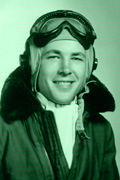
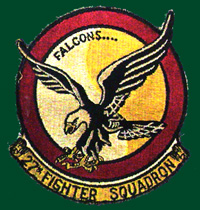
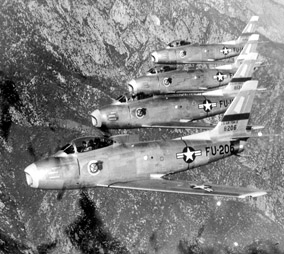
.jpg)
.jpg)
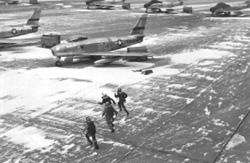
.jpg)
.jpg)
.jpg)
.jpg)
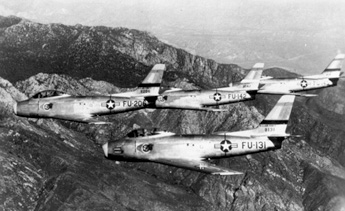
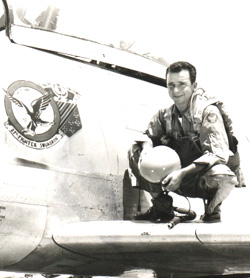
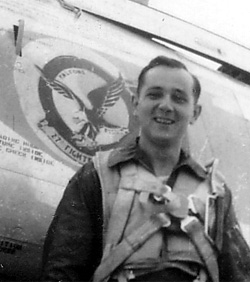
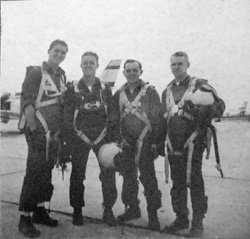
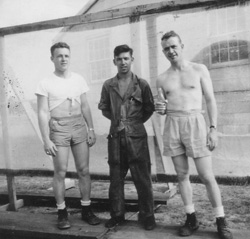
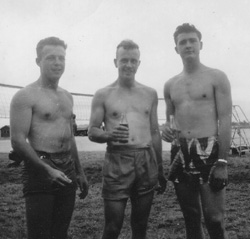
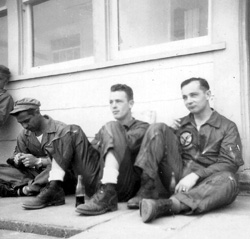
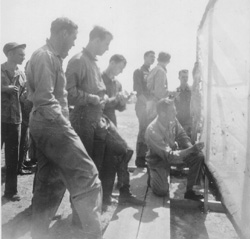
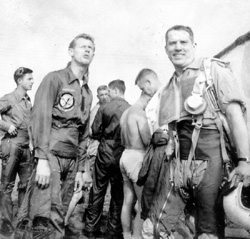
.jpg)